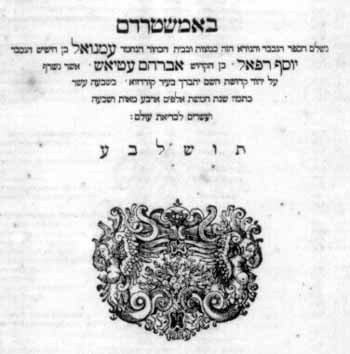The Work of Maimonides: Return to Spain
For a century and a quarter, no edition of the Mishneh Torah appeared, and but a few of the Tur, but editions of the Shulhan Aruch proliferated. It had become the widely accepted code, its predecessors of interest only to students of the Jewish legal tradition. The center of Hebrew printing had shifted from the cities of Italy, Turkey, and Poland to the cosmopolitan city of Amsterdam. At the end of the seventeenth century, Amsterdam's most distinguished printer of Hebrew books was Joseph Athias.Athias had become a highly successful publisher of books. For his splendid editions of the Hebrew Bible, he won the approbation of his colleagues and was honored by the government. As the century waned, Athias was coming to the end of his career and, as he must have suspected, to the last years of his eventful life. What more fitting way for a devout Jew to culminate a career rich in honors and accomplishments than by crowning it with a monumental edition of the classic work of a great Jewish scholar for whom he felt a special affinity.Joseph Athias was born in Cordoba, Spain, in 16 3 5, exactly 5 00 years after Maimonides's birth there. As a young man, Athias, like Maimonides, had to flee the city because of his loyalty to his ancestral faith. After some wandering, he settled in Amsterdam where, as Maimonides had done in Cairo, he attained distinction in his chosen calling. He knew what his crowning achievement should be, an edition of the Mishneh Torah, which would be the finest ever produced by a Hebrew press.
 |
In the last years of the century, Athias summoned the most skillful copyists and editors available, gathered the best manuscripts and combined them with the resources of one of the world's great presses. Printing began in 1698, but Athias did not live to see the edition's completion. He must have found some solace in the knowledge that his son and partner, Immanuel, would see it through. In 1702, a most splendid edition did appear, its size regal, its paper of the best quality, and its Hebrew type the finest anywhere. Illustrations were finely engraved. Moses Spitzer, the foremost authority on Hebrew typography, called this edition the greatest achievement of Hebrew typography. it is also a model of careful scholarship, a truly fitting monument to the greatest of medieval Jews.The edition was not only a monument but, alas, also a memorial. On its last printed page the colophon reads:
This great and noble edition was completed at the instance and in the printing house of the fine young man IMMANUEL, the son of the honored elder, JOSEPH RAPHAEL, the son of the martyr ABRAHAM ATHIAS, who was burned at the stake for the sanctification of God's blessed name in the city of Cordoba, on the seventeenth day of Tammuz, in the year of creation, five thousand, four hundred and twenty-seven [1667].*
Maimonides would have mourned the fact that in the city of his birth, more than five hundred years after his family was forced to flee from it, Abraham Athias, a Jew in his seventy-fifth year, was forced to sacrifice his life in fealty to his faith. Would Maimonides then not also have rejoiced that Abraham Athias's son Joseph took the advice Maimonides had offered half a millennium earlier, to flee the place of persecution and take up new and creative life in the service of his people and for the glory of God? This, too, is Kiddush hashem, sanctification of His Holy Name.
*It is remarkable that, 175 years after all Jews had been expelled from Spain, a descendant of a Jew who had been forced to convert to the dominant faith still clung to the ancestral faith with such tenacity and stubborn resolve that he chose martyrdom. And Abraham Athias was one among many, many martyrs.
Sources:Abraham J. Karp, From the Ends of the Earth: Judaic Treasures of the Library of Congress, (DC: Library of Congress, 1991).


